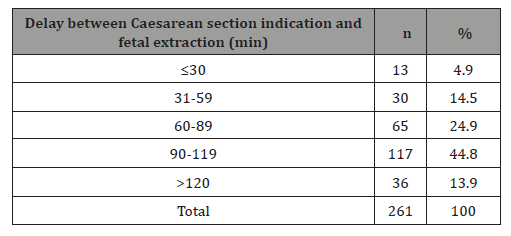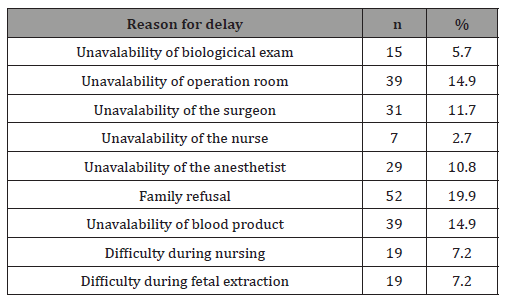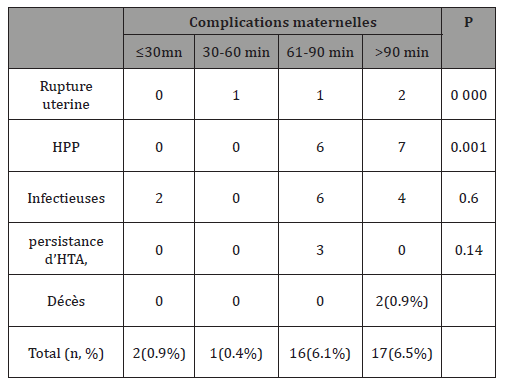 Research Article
Research Article
Time from Decision to Completion of Emergency Caesarean Section and Prognosis in N’Djamena Mother and Child University Hospital
Gabkika Bray Madoué1*, Foumsou Lhagadang1, Souam Nguélé Silé2 and Khadidja Mahayadine Salah1
1Department of genecology and obstetrics, N‘Djamena Mother and Child Hospital, Chad
2Department of pediatrics, N‘Djamena Mother and Child Hospital, Chad
Gabkika Bray Madoué, Department of genecology and obstetrics, N‘Djamena Mother and Child Hospital, Chad.
Received Date: February 27, 2020; Published Date: March 03, 2020
Abstract
Background: Caesarean section is a surgical procedure that performs delivery after opening the abdomen and uterus. According to the WHO, the ideal caesarean section rate should be between 10 and 15%. In Chad, the average rate of Caesarean section in urban areas is 9.3% [1]. Despite this rate, enough evidence can be identified to hinder the performance of emergency Caesarean section. That is why we initiated this study in order to see the minimum time required to perform an emergency cesarean section.
Patients and method: This were a descriptive and analytical study that collected prospective data, during a period of 2 months from July 1st, 2019 to August 31st, 2019, about time required to perform an emergency cesarean section and prognosis in N’Djamena Mother and Child University Hospital. All patients at whom emergency cesarean section was performed were included after getting their consent.
Result: During the study period, we record 287 cesareans sections among 845, giving a frequency of 33.9%. Two hundred sixty-one section cesarean was performed in emergency that 90.9%. One hundred and sixty-two patients (62%) were not referred. The average gestational age was 37.7 SA ± 2.9 gestational weeks with extremes of 28 gestational weeks and 42 gestational weeks. Among the 261 emergency Caesarean sections 219 cases (83.9%) were absolute emergencies. The main indications for cesarean section were scarring uterus (24.1%), fetal and maternal disproportion (13.7%), and stagnation of the cervix dilation (13%), eclampsia/preeclampsia (11.4%) perinatal asphyxia (6%). The interval time form indication of caesarean section and fetal extraction was between 90-119 minutes for 117 patients (44.8%). The family refusal was the first reason of the delay representing 19.9%. Beyond 60 minutes of the delay the maternal prognostic is worst. We had recorded 33 complications (12.6%). After 60 mn more fetal complication are noted represented by perinatal asphyxia, neonatal infection and fetal death.
Conclusion: The average time to perform emergency Caesarean section remains high by compared with standards. The family’ refusal of the cesarean section is the first cause of the delay to perform the emergency cesarean section.
Keywords: Emergency caesarean section; Time; Prognosis
Introduction
Caesarean section is a surgical procedure that performs delivery after opening the abdomen and uterus [1]. Globally, there is a disparity in Caesarean section rates, with rates as high as 40% in some areas and 5% in the developing world [2]. According to the WHO, the ideal caesarean section rate should be between 10 and 15% [2]. Regardless of its prevalence, it must be performed within a reasonable time that does not threaten maternal and fetal life. However, there are various factors that can delay it [3]. That is why the literature reported an inequality in the minimum time required to perform a cesarean section. In the same way Lucas [3,4,5], proposed the minimum time for performing cesarean sections according to the codes. In Chad, the average rate of Caesarean section in urban areas is 9.3% [6]. Despite this rate, enough evidence can be identified to hinder the performance of emergency Caesarean section. That is why we initiated this study in order to see the minimum time required to perform an emergency cesarean section.
Patients and Method
This was a descriptive and analytical study that collected prospective data, during a period of 2 months from July 1st, 2019 to August 31st, 2019, about time required to perform an emergency cesarean section and prognosis in N’Djamena Mother and Child University Hospital. All patients at whom emergency cesarean section was performed were included after getting their consent.
Patients were recruited by the medical students without informing the surgeon and other staff member. Then patients and newborns are followed until they are discharged from hospital to identify a complication. The studied variable was epidemiological, clinical and prognoses. SPSS version 18.0 was used to analyze data p value was significant when less than 0.05.
Results
During the study period, we record 287 cesareans sections among 845, giving a frequency of 33.9%. Two hundred sixty-one section cesarean was performed in emergency that 90.9%.
One hundred and sixty-two patients (62%) were not referred. The remainder was referred by surrounding health center (38%) (Table 1).
Table 1: Gestational age.

The average gestational age was 37.7 SA ± 2.9 gestational weeks with extremes of 28 gestational weeks and 42 gestational weeks. The majority of patients (74.6%) were at term.
Among the 261 emergency Caesarean sections 219 cases (83.9%) were absolute emergencies. The remainder (16.9%) was related to emergencies.
The main indications for cesarean section were: scarring uterus (n=63, 24.1%), fetal and maternal disproportion(n=36, 13.7%), stagnation of the cervix dilation (n=33, 13%), eclampsia/ preeclampsia (n=30, 11.4%) perinatal asphyxia (n=15, 6%) (Table 2).
Table2 : Delay between Caesarean section indication and fetal extraction.

The interval time form indication of caesarean section and fetal extraction was between 90-119 minutes for 117 patients (44.8%). The average time was 135 minutes with extremes ranging from 35 minutes to 4h 27 minutes (Table 3).
Table 3: Gestational age.

The family refusal was the first reason of the delay representing 19.9% Beyond 60 minutes of the delay the maternal prognostic is worst. We had recorded 33 complications (12.6%) presented essentially by uterine rupture and postpartum hemorrhage.
Table 3: Gestational age.

Two maternal deaths were recorded mainly in patients treated after 90 min. After 60 min more fetal complication are noted represented by perinatal asphyxia, neonatal infection and fetal death (Tables 4&5).

Discussion
Among 287 Caesarean sections performed, 261 (90.9%) were an emergency caesarean section. Our rate is higher than those of Ymélé F [7] in Yaoundé in Cameroon in 2019 and Nannali P, et al [8] in Finland in 2010, which had reported respectively 84.15% and 45.6%. This rate is also higher than WHO’ standards [2] ranging from 10-15%. The majority of patients (62%) were not referred. This rate contrasts with the status of the Mother and Child Hospital, which is supposed to receive only many referrals. This can be explaining by the application of the policy of exemption fees for emergency cesarean section more perceived in N’Djamena Mother and Child University Hospital.
The majority (74.6%) of patients carried term pregnancy. This is similar with findings of many authors [6, 7, 9] across the world that had reported a proportion of patients with term pregnancy ranging between 76.6 -84%.
The majority of C-sections in our series (83.9%) were absolute emergencies. Our rate is higher than Bello’s [9], which noted the rate of 62% for absolute emergency caesarean section. However, it is lower than the reports of Birjma’s[10], Chow and al in Hong Kong (China) in 2015 [34] and Oppong in Ghana in 2014 [11], which had the of an absolute emergency caesarean section ranging from 91.5- 95%.
According to the literature, the proportions about of caesarean sections indications are variable from one study to another [5]. However, some indications remain similar for many authors, such as Teubeu [12], Birjma [10] and Oppong [11] that had noted a high proportion of fetal and maternal disproportion varying from 23.1-31%. In this study, scarred uterus was more represented with 24.1% followed by fetal and maternal disproportion with 13.7%.
The time from the indication of caesarean section to fetal extraction was between 90-119 minutes for 117 patients (44.8%). According to the RCOG recommendations, the maximum time from indication to the extraction is 30 minutes [13]. In current practice, this deadline is rarely met [14] but additional efforts are needed to get closer to the standard. The average interval was 135 min with extremes ranging from 35 mn and 04h 27 mn which is largely higher compared to the commonly accepted 30 minutes.
In our series, several factors influenced the time from indication of caesarean section to fetal extraction. These factors were: refusal of cesarean section by the family (19.9%), unavailability of the operating room (14.9%), unavailability of blood product (14.9%). Ymélé [7] on the other hand notes that the unavailability of the cesarean section kit was the first cause of the delay with represented 84.3%. The delay like family’s refusal of cesarean section is a Chadian specificity. Surgeons are therefore obliged to wait for the signature of the consent form before starting the intervention. This factor found specifically under our country, associated with others like dystocia identified by in other authors [2,9,11,15], can favor the occurrence of the hemorrhage mainly after caesarean section.s
The main causes of delays have been reported by many studies and distinguish two key moments: the “decision-arrival in the operating room” delay and the placement of anesthesia [14,16]. It is therefore on these two stages that the teams must progress.
Beyond 60 minutes, the delay of fetal extraction is associated with maternal complications such as immediate postpartum hemorrhage and uterine rupture. We recorded 33 maternal complications (12.6%) when fetal extraction occurred within more than 60 minutes. Any delay in the management of these bleeds is likely to lead to maternal death. Two maternal deaths were recorded (0.9%). This result is better than those of Bokossa in 2008 at the University Hospital of Cocody [15] and Tebeu, et al. [12] which reported 15.2% and an average of one maternal death among patients that delivered by caesarean.
According to Ymele, et al. [7] and Bello, et al. [9], the occurrence perinatal asphyxia and neonatal infection in the context of fetal and maternal disproportion, were significantly less frequent when the delay of cesarean section was less than 120 minutes. The fetal stage deteriorates for a long period of delay during fetal extraction [2]. Thus, any delay in the management of cesarean sections can influence the fetal stage. Our result corroborates these findings with 21 complications out of 30 or 7.7% when extraction occurred after 60 minutes
Conclusion
The average time to perform emergency Caesarean section remains high by compared with standards. The family’ refusal of the cesarean section is the first cause of the delay to perform the emergency cesarean section. Maternal and fetal prognosis remains linked with the minimal time of fetal extraction.
Acknowledgement
None.
Conflict of Interest
No conflict of interest.
References
- Ymele F, Chancelle NN, Jeanne HF, Loic DF, Robinson EM, et al. (2019) Time from decision to completion of emergency C-section Health Sci 2: 13-9.
- World Health Organization (2015) WHO Statement on Caesarean Section Rates. World Health Organization.
- Tchantou TD, Mpiga E, Mbang J, Salami A, Avome C, et al. (2019) Delay in performing emergency caesarean sections at the OMAR BONGO ONDIMBA army institution hospital. Summary of the book 4th Franco-Cameroonian Congress of Gynecology and Obstetrics: 48-49.
- Lucas DN, Yentis SM, Kinsella SM, Holdcroft A, Ma AE, et al. (2000) Urgency of Caesarean Section: A New Classification. J R Soc Med 93(7): 346-350.
- Root C, Meddoun M (2001) Caesareans. Encycl Méd Chir. Surgical techniques 41: 1-20.
- Quevauvilliers J (2007) Medical Dictionary. 5th (edn), Paris Masson, p172.
- Nanneli P, Ulla E, Tallberg AA, Uotila J, Raudaskoski T, et al. (2010) Cesarean Delivery in Finland: Maternal Complications and Obstetric Risk Factors. Acta Obstet Gynecol Scand 89(7): 896-902.
- Bello FA, Tsele TA, Oluwasola TO (2015) Decision-to-delivery interval and perinatal outcomes following emergency Caesarean section in a Nigerian tertiary hospital. Int J Gynaecol Obstet 130(3): 279-278.
- Birjna AH, Bariki LM, Mazuguni NS, Mahande MJ (2017) The decision delivery interval in emergency caesarean section and its associated maternal and fetal outcomes at a referral hospital in northern Tanzania : a cross sectional study. BMC Pregnancy and Childbirth 17: 411-418.
- Oppong SA, Tuuli MG, Seffah JD, Adanu RM (2014) Is there a safe time limit for an emergency C-section in Ghana? Results of early perinatal outcome analysis. Ghana Med J 48(1): 24-30.
- Tebeu PM, Ngassa P, Mboudou E, Kongnygny EJ, Binam F, et al. (2008) Neonatal survival following cesarean delivery in northern Cameroon. Int J Gynecol Obstet 103(3) : 259-260.
- Chow KM, Mak SL (2015) Maternal and fetal outcomes in extremely urgent caesarean section delivery in relation to the decision-to-delivery interval. Hong Kong J Gynaecol Obstet Midwifery 15(1): 16-19.
- Sayegh I, Dupuis O, Clement HJ, Rudigoz RC (2004) Evaluating the decision--to-delivery interval in emergency caesarean sections. Eur J Obstet Gynecol Reprod Biol 116(1): 28-33.
- Bokossa M, Nguessan K, Doumbia Y, Kakou C, Djoubou C, et al. (2008) Prophylactic and emergency caesarean section for 394 cases at Cocody University Hospital. Med Afrique Noire 5511: 593-601.
- Helmy WH, Jolaoso AS, Ifaturoti OO, Afify SA, Jones MH (2002) The decision-to-delivery interval for emergency caesarean section : is 30minutes a realistic target ? BJOG 109(5): 505-508.
- Foumane P, Mve KV, Ze Minkande J, Njofang NE, Dohbit JS, et al. (2014) Risk factors and prognosis of emergency césarien delivery at the Yaoundé women's and children's Hospital, Cameroon. Med Santé Trop 24 : 89-89.
-
Gabkika Bray M, Foumsou L, Souam N S, Khadidja Mahayadine Salah. Time from Decision to Completion of Emergency Caesarean Section and Prognosis in N’Djamena Mother and Child University Hospital. W J Gynecol Women’s Health. 3(3): 2020. WJGWH.MS.ID.000556.
Emergency caesarean section, Time, Prognosis, Abdomen, Uterus, Gestation, Perinatal asphyxia, Postpartum hemorrhage, Neonatal infection, Fetal death
-

This work is licensed under a Creative Commons Attribution-NonCommercial 4.0 International License.






